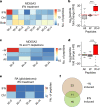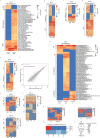Tryptophan depletion results in tryptophan-to-phenylalanine substitutants
- PMID: 35264796
- PMCID: PMC8942854
- DOI: 10.1038/s41586-022-04499-2
Tryptophan depletion results in tryptophan-to-phenylalanine substitutants
Erratum in
-
Author Correction: Tryptophan depletion results in tryptophan-to-phenylalanine substitutants.Nature. 2022 Aug;608(7922):E20. doi: 10.1038/s41586-022-05097-y. Nature. 2022. PMID: 35840685 Free PMC article. No abstract available.
Abstract
Activated T cells secrete interferon-γ, which triggers intracellular tryptophan shortage by upregulating the indoleamine 2,3-dioxygenase 1 (IDO1) enzyme1-4. Here we show that despite tryptophan depletion, in-frame protein synthesis continues across tryptophan codons. We identified tryptophan-to-phenylalanine codon reassignment (W>F) as the major event facilitating this process, and pinpointed tryptophanyl-tRNA synthetase (WARS1) as its source. We call these W>F peptides 'substitutants' to distinguish them from genetically encoded mutants. Using large-scale proteomics analyses, we demonstrate W>F substitutants to be highly abundant in multiple cancer types. W>F substitutants were enriched in tumours relative to matching adjacent normal tissues, and were associated with increased IDO1 expression, oncogenic signalling and the tumour-immune microenvironment. Functionally, W>F substitutants can impair protein activity, but also expand the landscape of antigens presented at the cell surface to activate T cell responses. Thus, substitutants are generated by an alternative decoding mechanism with potential effects on gene function and tumour immunoreactivity.
© 2022. The Author(s).
Conflict of interest statement
The authors declare no competing interests.
Figures











Comment in
-
Immune cells alter genetic decoding in cancer.Nature. 2022 Mar;603(7902):582-583. doi: 10.1038/d41586-022-00637-y. Nature. 2022. PMID: 35264802 No abstract available.
References
-
- Amobi A, Qian F, Lugade AA, Odunsi K. Tryptophan catabolism and cancer immunotherapy targeting IDO mediated immune suppression. Adv. Exp. Med. Biol. 2017;1036:129–144. - PubMed
MeSH terms
Substances
Grants and funding
LinkOut - more resources
Full Text Sources
Other Literature Sources
Molecular Biology Databases
Research Materials
Miscellaneous

